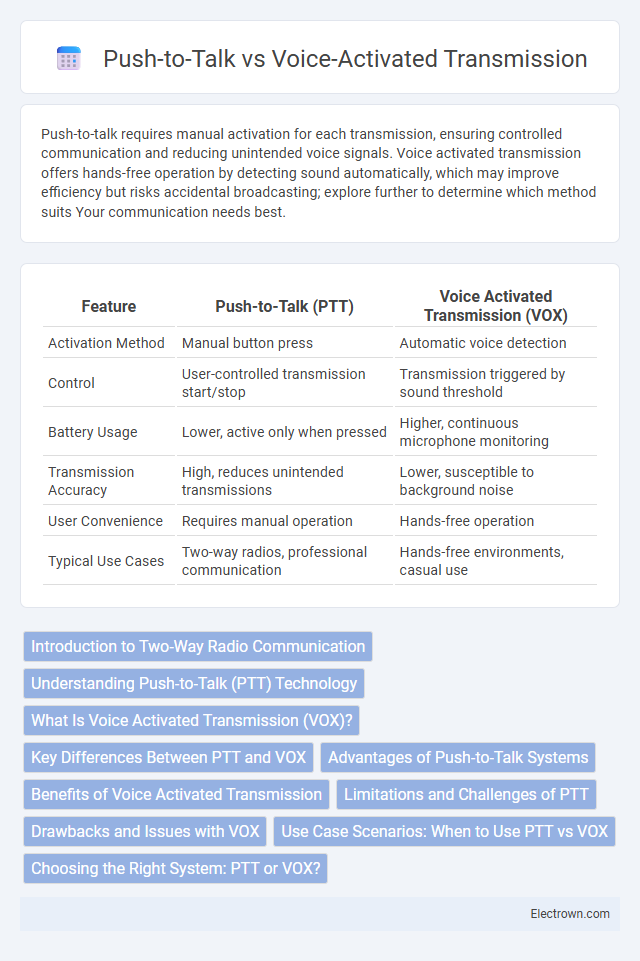Push-to-talk requires manual activation for each transmission, ensuring controlled communication and reducing unintended voice signals. Voice activated transmission offers hands-free operation by detecting sound automatically, which may improve efficiency but risks accidental broadcasting; explore further to determine which method suits Your communication needs best.
Table of Comparison
| Feature | Push-to-Talk (PTT) | Voice Activated Transmission (VOX) |
|---|---|---|
| Activation Method | Manual button press | Automatic voice detection |
| Control | User-controlled transmission start/stop | Transmission triggered by sound threshold |
| Battery Usage | Lower, active only when pressed | Higher, continuous microphone monitoring |
| Transmission Accuracy | High, reduces unintended transmissions | Lower, susceptible to background noise |
| User Convenience | Requires manual operation | Hands-free operation |
| Typical Use Cases | Two-way radios, professional communication | Hands-free environments, casual use |
Introduction to Two-Way Radio Communication
Two-way radio communication relies on push-to-talk (PTT) and voice-activated transmission (VOX) as primary methods for managing audio signals. Push-to-talk requires users to manually press a button to transmit, providing clear control over communication and minimizing unintended broadcasts. Voice-activated transmission automatically detects sound, enabling hands-free operation but may increase the risk of background noise being transmitted.
Understanding Push-to-Talk (PTT) Technology
Push-to-Talk (PTT) technology allows instantaneous communication by pressing a button to transmit voice, commonly used in two-way radios and mobile apps for efficient group coordination. Voice Activated Transmission (VOX) enables hands-free communication by automatically detecting voice and transmitting without manual input, ideal for environments requiring multitasking. PTT offers precise control over when to speak, reducing unwanted transmissions, whereas VOX prioritizes convenience but may trigger false activations in noisy settings.
What Is Voice Activated Transmission (VOX)?
Voice Activated Transmission (VOX) is a communication technology that automatically activates your radio or device when it detects your voice, eliminating the need to press a button to transmit. This hands-free feature ensures seamless conversations, especially in environments where manual operation is impractical or unsafe. VOX sensitivity can be adjusted to avoid background noise triggers, optimizing clarity and transmission efficiency.
Key Differences Between PTT and VOX
Push-to-talk (PTT) requires manual button activation to transmit audio, ensuring precise control over when your message is sent, whereas voice-activated transmission (VOX) automatically detects sound and begins transmitting without manual input. PTT reduces accidental transmissions and background noise interference, making it ideal for noisy environments, while VOX offers hands-free convenience, enhancing multitasking and rapid communication. Understanding these key differences helps you choose the method that best suits your communication needs and operational conditions.
Advantages of Push-to-Talk Systems
Push-to-Talk (PTT) systems offer precise control over communication by requiring users to manually activate the microphone, reducing unintended transmissions and background noise. These systems enhance security and confidentiality by limiting voice transmission to intentional, user-initiated moments. PTT technology also improves network efficiency, as it minimizes channel congestion and optimizes bandwidth usage compared to continuous voice-activated transmission.
Benefits of Voice Activated Transmission
Voice Activated Transmission (VOX) enables hands-free communication by automatically transmitting voice signals when sound is detected, increasing convenience and safety in environments where manual operation is impractical. This technology reduces the need for pressing buttons, allowing you to maintain focus on tasks without interruption, which is particularly beneficial in industries like construction, emergency services, and logistics. VOX enhances efficiency and responsiveness by ensuring seamless and immediate voice transmission, optimizing real-time communication workflows.
Limitations and Challenges of PTT
Push-to-talk (PTT) communication faces limitations such as requiring users to physically press a button, which can delay response times and hinder multitasking in critical situations. Background noise and signal interference often affect the clarity and reliability of transmissions, posing challenges in dynamic or noisy environments. Battery consumption can be high due to constant signal retention, reducing operational time for users relying on PTT devices.
Drawbacks and Issues with VOX
Voice activated transmission (VOX) often suffers from false activations due to background noise, leading to unintended transmissions that disrupt communication channels. VOX systems may also experience latency in voice detection, causing delays and missed message cues. Unlike push-to-talk, which provides explicit control over transmission, VOX can drain battery life faster due to continuous microphone monitoring and sensitivity adjustments.
Use Case Scenarios: When to Use PTT vs VOX
Push-to-talk (PTT) is ideal for noisy environments or situations requiring precise, controlled communication, such as emergency services, military operations, or construction sites where background noise is substantial. Voice activated transmission (VOX) suits hands-free scenarios with moderate noise levels, like office settings or casual group chats, enabling seamless communication without manual activation. Selecting between PTT and VOX depends on the need for control over transmissions and ambient noise conditions, balancing clarity with convenience.
Choosing the Right System: PTT or VOX?
Choosing between Push-to-Talk (PTT) and Voice Activated Transmission (VOX) depends on the communication environment and user preference. PTT systems provide precise control with manual activation, ideal for noisy or sensitive situations, while VOX offers hands-free convenience, enhancing mobility in less noisy settings. Evaluating factors such as background noise levels, response time requirements, and operational ease ensures selecting the most effective transmission method.
Push-to-talk vs Voice activated transmission Infographic

 electrown.com
electrown.com